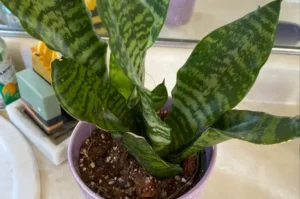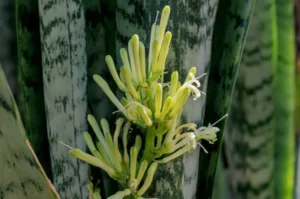Snake plants are admired for their tall, upright, and architectural leaves. But what happens when your snake plant starts growing sideways or spreading out instead of reaching upward? If you’re noticing your plant leaning outward, flopping over, or taking on a more open shape, you’re not alone. This is a common concern among indoor plant owners.
In this article, we’ll explore the possible reasons why your snake plant is growing outward, whether it’s something to worry about, and how to help your plant grow more upright and strong.
Is Outward Growth Normal in Snake Plants?
Yes, in many cases, outward growth is a normal part of your snake plant’s development. Snake plants, also known as Sansevieria or Dracaena trifasciata, don’t always grow straight up. Depending on the species, environment, and age of the plant, it may naturally spread or lean outward.
However, sometimes this kind of growth can indicate that the plant is not receiving the right care or is reacting to its environment. Understanding the causes will help you decide whether to adjust your plant care routine.
1. Not Enough Light
One of the most common reasons snake plants grow outward is due to insufficient lighting. In low light, the plant will often reach or lean toward the nearest light source, causing it to grow sideways rather than vertically.
What You Can Do:
- Place your plant near a bright window with indirect sunlight.
- Rotate the pot regularly to ensure all sides receive equal light.
- Avoid deep shade or dark corners for long periods.
2. Overwatering and Root Problems
Overwatering can weaken the roots, making it difficult for the plant to hold its leaves upright. If the roots are damaged or beginning to rot, the plant may lose its structure and start to fall outward.
How to Fix It:
- Check that the soil is well-draining.
- Use pots with drainage holes.
- Allow the soil to dry out before watering again.
- If you suspect root rot, remove the plant, trim the damaged roots, and repot in fresh soil.
3. Underwatering
While snake plants are drought-tolerant, extreme lack of water can cause dehydration. When that happens, the leaves may start to droop or grow outward due to a lack of internal moisture and pressure.
Solution:
- Water the plant when the top 2–3 inches of soil feel dry.
- Avoid letting the plant stay dry for too long, especially during hot months.
- Ensure consistent but not excessive watering.
4. Heavy or Mature Leaves
As the plant matures, older leaves become long and heavy. Sometimes, these mature leaves lose their firmness and begin to bend outward, especially when there are many thick leaves in one container.
What Helps:
- Trim overly heavy or floppy leaves using sterilized scissors.
- Don’t worry too much if it’s just a few older leaves, it’s a natural process.
- Add a support stake or ring if needed to hold the leaves upright.
5. Crowded Roots or Pot Size
Snake plants grow from underground rhizomes. As they expand, the pot can become overcrowded. When there’s not enough space, new shoots may be pushed outward, and roots can’t support vertical growth effectively.
Best Practices:
- Repot your snake plant every 1–2 years.
- Choose a pot that’s slightly larger and deeper than the current one.
- Use cactus or succulent mix for best drainage.
6. Genetics and Plant Variety
Some snake plant varieties naturally grow in a more open or outward pattern. Not all types are upright. For example, Sansevieria cylindrica often grows in a fan shape, and some dwarf types tend to spread rather than climb.
What to Know:
- Identify your plant variety to understand its natural growth habit.
- Outward growth may not be a problem at all, just part of its nature.
- Don’t fight its natural form if it’s healthy and growing well.
7. Inconsistent Temperature or Drafts
Sudden temperature changes or cold drafts can stress your snake plant. This stress can affect the plant’s internal structure, making leaves droop or bend outward instead of standing straight.
To Avoid This:
- Keep your plant in a stable environment, ideally between 60°F to 85°F (16°C to 29°C).
- Avoid placing it near doors, vents, heaters, or air conditioning units.
- Don’t expose it to cold windows in winter.
Should You Be Concerned?
Outward growth isn’t always a bad sign. If your plant looks healthy overall with firm, green leaves and no signs of pests or rot, you may not need to do anything drastic.
However, if the plant is falling over completely, turning yellow, or smelling bad, those are signs of trouble. In such cases, you should check the roots, adjust watering, and possibly repot the plant.
Tips to Encourage Upright Growth
If you prefer your snake plant to grow straight up, here are a few simple tips:
- Improve lighting: Natural light helps the plant grow more vertically.
- Support your plant: Use stakes or plant supports for tall leaves.
- Keep the soil right: Use a fast-draining potting mix.
- Repot when needed: A tight root space can cause leaning growth.
- Prune selectively: Trim off weak or floppy leaves at the base.
Conclusion
A snake plant that’s growing outward can be normal or a sign that something in its environment needs adjusting. Factors like lighting, watering habits, root space, and even genetics play a role in how your plant grows.
By observing your snake plant and providing the right care, you can help it thrive in any shape, whether it grows tall and upright or spreads out with character. After all, healthy plants come in many forms, and sometimes, a little lean gives them a unique charm.






